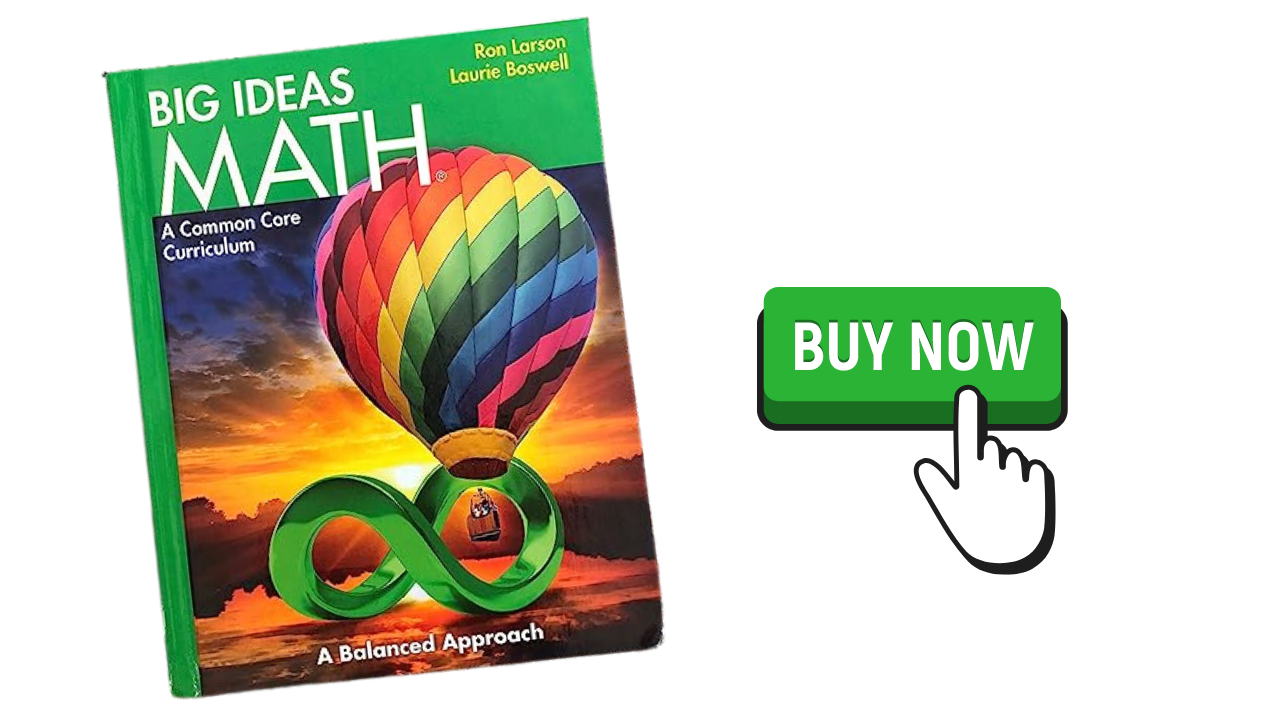Big Ideas Math Chapter 7 Answer Key

Introduction
Welcome to this comprehensive guide on the Big Ideas Math Chapter 7 answer key. In this article, we will explore the importance of accessing the answer key, how to use it effectively, and provide sample questions and answers for your reference. Whether you're a student seeking assistance or an educator looking for additional resources, this guide will help you navigate through Chapter 7 with confidence.
Big ideas math chapter 7 answer key
Chapter 7 math worksheets
Chapter 7 math games
Chapter 7 math quizzes
Math videos
Overview of Big Ideas Math Chapter 7
Big Ideas Math Chapter 7 is a crucial section of the curriculum that covers specific mathematical concepts and skills. The chapter focuses on a particular topic that may vary depending on the edition or version of the Big Ideas Math textbook being used. It is designed to deepen students' understanding and proficiency in math by introducing new concepts and providing opportunities for practice and application.
Chapter 7 typically builds upon the foundation established in previous chapters and prepares students for more advanced topics to come. It may cover topics such as algebraic expressions, equations, inequalities, functions, graphing, or geometric concepts, depending on the specific curriculum. The chapter aims to enhance problem-solving abilities, logical reasoning, critical thinking, and mathematical fluency.
Throughout Chapter 7, students will encounter a variety of exercises and problems that require them to apply the concepts and techniques learned. These may include solving equations, analyzing patterns, graphing functions, working with variables, or exploring geometric relationships. The chapter often includes real-world applications and contextual problems to demonstrate the practical relevance of the mathematical concepts being taught.
In addition to the core content, Chapter 7 may also incorporate interactive activities, group work, and opportunities for discussion and reflection. These elements aim to engage students actively in the learning process, foster collaboration, and develop their mathematical communication and reasoning skills.
It is essential for students to approach Chapter 7 with a solid understanding of the foundational concepts covered in earlier chapters. This will allow them to build upon their existing knowledge and grasp the more advanced topics presented. Regular practice, active participation, and seeking help when needed are key to success in mastering the content of Big Ideas Math Chapter 7.
Importance of Accessing the Answer Key
Accessing the answer key for Big Ideas Math Chapter 7 is an important resource for students, teachers, and parents alike. Here are some reasons why accessing the answer key is valuable:
- Self-Assessment: The answer key allows students to check their work and verify if their answers are correct. It provides immediate feedback, enabling students to identify any errors or misconceptions and make necessary corrections. This self-assessment process promotes independent learning and helps students monitor their progress.
- Learning from Mistakes: Reviewing the answer key allows students to understand where they went wrong in solving a problem. By analyzing the correct solutions, they can identify errors in their approach, misconceptions, or gaps in their understanding. This process helps students learn from their mistakes and improve their problem-solving strategies.
- Guided Practice: The answer key serves as a guide for students during practice sessions. It allows them to compare their work with the correct solutions, helping them understand the steps and procedures required to solve different types of problems. This guidance promotes a deeper understanding of the concepts and fosters a stronger foundation in mathematics.
- Targeted Review: The answer key provides a valuable resource for targeted review. Students can revisit specific problems or sections where they struggled and use the answer key to analyze the correct solutions in detail. This targeted review helps reinforce their understanding, address misconceptions, and improve their performance.
- Teacher Support: The answer key is an essential tool for teachers as well. It allows them to assess student progress, identify common mistakes or misconceptions, and tailor their instruction accordingly. By reviewing the answer key, teachers can gain insights into the areas where students may need additional support and adjust their teaching strategies to address those needs effectively.
How to Use the Answer Key
Using the answer key for Big Ideas Math Chapter 7 effectively can enhance the learning experience and promote a deeper understanding of the concepts. Here are some tips on how to use the answer key:
- Solve the Problems Independently: Before checking the answer key, attempt to solve the problems on your own. This allows you to engage in the problem-solving process and think critically about the concepts and strategies involved.
- Compare Your Answers: Once you have completed the problems, compare your answers with those in the answer key. Pay attention to any differences and identify any mistakes or areas where you may have struggled.
- Analyze the Solutions: For the problems you got incorrect or were unsure about, analyze the correct solutions provided in the answer key. Review the steps and procedures used to solve the problems, and compare them with your own approach. Identify any errors or misconceptions and understand the correct methods.
- Seek Understanding: Use the answer key as a learning tool to gain a deeper understanding of the concepts. If you don't understand a particular step or solution, consult your textbook or ask your teacher for clarification. Make sure to grasp the underlying concepts and reasoning behind the solutions.
- Learn from Mistakes: If you made mistakes, take the opportunity to learn from them. Understand the reasons for your errors and identify any patterns or common misconceptions. This reflection will help you avoid similar mistakes in the future and improve your problem-solving skills.
- Seek Support if Needed: If you are consistently struggling with certain concepts or problems, don't hesitate to seek additional support. Talk to your teacher, join study groups, or access online resources to reinforce your understanding and receive guidance.
Sample Questions and Answers
Here are some sample questions and answers for Big Ideas Math Chapter 7:
-
Question: Solve the equation 2x + 5 = 17.
Answer: To solve the equation, we subtract 5 from both sides: 2x = 12. Then, divide both sides by 2 to isolate x: x = 6. -
Question: Simplify the expression 3x² + 2x - 5x² - 4x + 7.
Answer: To simplify the expression, we combine like terms: -2x² - 2x + 7. -
Question: Solve the inequality 4x + 6 > 18.
Answer: To solve the inequality, we subtract 6 from both sides: 4x > 12. Then, divide both sides by 4 to isolate x: x > 3. -
Question: Graph the linear equation y = 2x - 3.
Answer: To graph the equation, we plot points on the coordinate plane using the slope-intercept form. The line has a slope of 2 and y-intercept of -3. Starting at the y-intercept, we move up 2 units and to the right 1 unit to plot another point. We can continue this process to draw the line. -
Question: Find the area of a triangle with a base of 8 units and a height of 6 units.
Answer: The formula for the area of a triangle is A = (1/2) * base * height. Substituting the given values, we get A = (1/2) * 8 * 6 = 24 square units.
Frequently Asked Questions
-
What is the purpose of the answer key in Big Ideas Math?
The answer key serves as a resource for students and educators to check the correctness of their solutions and gain insights into problem-solving strategies. -
Q: Where can I find the answer key for Chapter 7?
You can find the answer key for Chapter 7 in your Big Ideas Math textbook or through online resources provided by your school or publisher. Consult your teacher or school administration for the specific location or access instructions. -
Q: How can I use the answer key effectively?
To use the answer key effectively, solve the problems independently first, compare your solutions with the provided answers, analyze any discrepancies, and review the explanations and methods used in the answer key to enhance your understanding.
Conclusion
In conclusion,the answer key for Big Ideas Math Chapter 7 serves as a valuable resource for students studying the chapter. It provides a comprehensive set of solutions to the exercises and problems presented in the chapter, allowing students to check their work and verify their answers. Accessing the answer key helps students to understand the concepts better, identify any mistakes they may have made, and learn from them. It promotes self-assessment and independent learning, enabling students to gauge their progress and reinforce their understanding of the mathematical principles covered in Chapter 7. The answer key serves as a valuable tool in the learning process, empowering students to develop their problem-solving skills and build confidence in their mathematical abilities. However, it is important to use the answer key as a learning aid rather than a shortcut, and to seek further clarification or assistance when needed.

